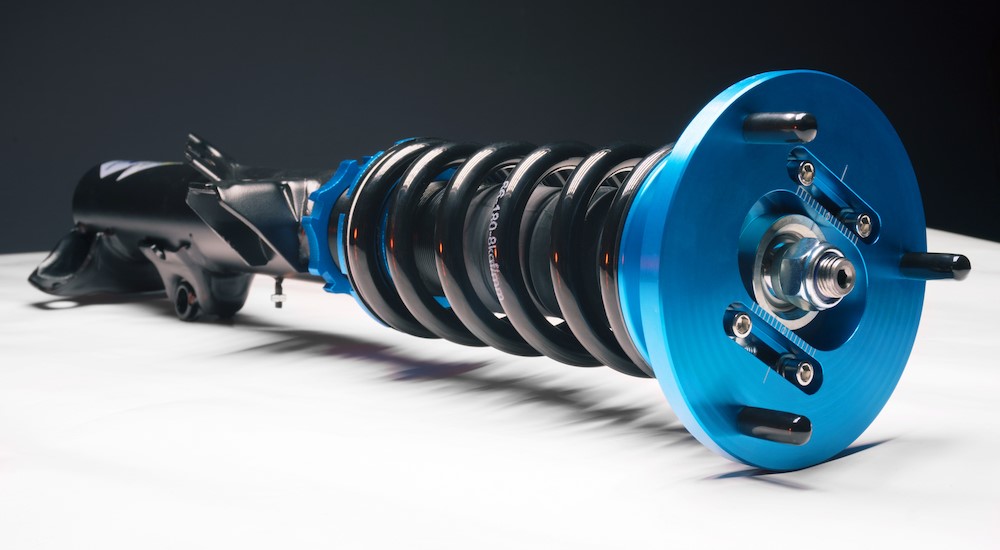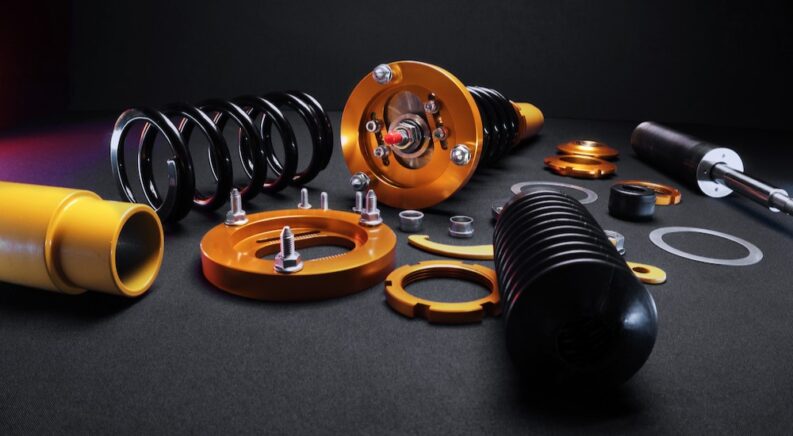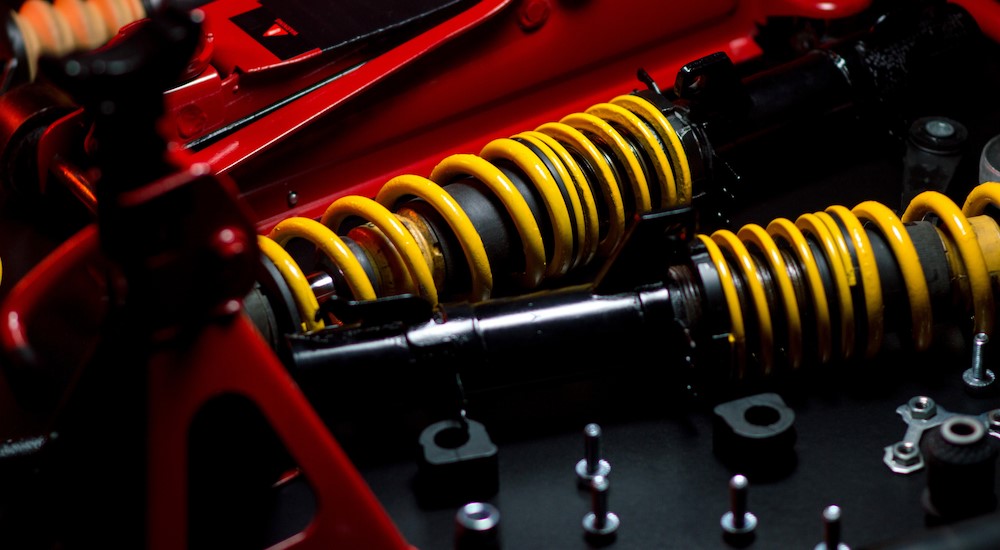A vehicle’s stock suspension is usually designed to smooth out the bumps in the road and make for a more comfortable ride. However, these shock-absorbing qualities often come at the cost of performance. If you want to give your vehicle an edge and unlock its true potential, it might be time to consider adding a set of coilovers. Coilovers can have a huge impact when it comes to strengthening the connection between a driver and their car, enhancing stability, and sharpening steering inputs to help your vehicle carve through corners while minimizing the sort of body roll that can reduce traction and performance. What do drivers need to know when it comes time to upgrade their stock suspension with aftermarket coilovers? We’ll walk you through the process, share a few important tips, and see what a difference a good set of coilovers can make when you’re behind the wheel.
What Are Coilovers?
While every vehicle comes with a standard set of shock absorbers (also known as struts or dampers), a coilover represents a drastic improvement on the typical formula. The word is actually short for “coil over shock absorber”, which manages to sum up the basic design in four short words. A coilover consists of a traditional damper encircled by a coil spring, along with other components like bushings, bump stops, mounts, and various hardware, and offers several advantages over dampers alone.
With the exception of some factory-installed products, most coilovers are adjustable, allowing drivers to customize the suspension’s height, preload, rebound, compression, and more to improve handling and performance. Coilovers are particularly well-suited for use on sports cars and other performance-minded vehicles where comfort often takes a backseat to handling and responsiveness. A vehicle’s stock suspension might feel a little squishy through the corners as the suspension compresses and tilts the car to one side, but the springs used in coilovers are able to better withstand these cornering forces by subtly compressing and returning to their original shape to keep your ride a little more level.
All in all, coilovers give drivers the opportunity to adjust four different suspension characteristics. Swapping out the coilover’s springs with a set that offers a higher spring rate can help to decrease a vehicle’s tendency to experience roll when cornering. Ride height can also be adjusted by opting for coilovers with threaded springs, seats, or bottom brackets, improving ground clearance or allowing you to live out your lowrider dreams. Coilovers fitted with adjustable dampers allow dialing in the suspension’s compression and rebound, which describe how well the shock absorbers control movement when they encounter a bumpy patch of pavement or a sharp turn.
Finally, there’s camber and caster. If your new coilovers come with adjustable top mounts, you can tailor your vehicle’s camber and caster to improve grip, handling, and stability. Camber is the inward or outward tilt of the wheels when viewed from the front of the vehicle. Positive camber means the tops of the wheels tilt away from the vehicle, while negative camber causes the top of the wheel to tilt inward towards the vehicle. Customizing your camber can increase the contact patch between the tires and the road while cornering, which can noticeably affect handling.
Caster is the same idea on a different plane, describing how much the steering axis tilts towards the rear of the vehicle (positive caster) or the front of the vehicle (negative caster). Positive caster results in more steering stability, but also increases the amount of force required to move the steering wheel.

How to Choose Coilovers
There are a few key factors a driver should keep in mind when looking for a new set of coilovers. From ensuring they’re designed to accommodate your specific make, model, and suspension type to your intended use, desired ride height, and more, let’s dive into a few of the requirements you should keep in mind when attempting to upgrade your ride.
Desired Driving Style
The first step in shopping for coilovers comes down to your vehicle’s intended use. A track-oriented sports car is going to require a drastically different setup from an off-road adventure rig or a daily driver, which is why it’s so vital that drivers have a clear picture of what sort of vehicle they’re trying to build. Let’s say you want to create a dedicated racer to dominate the podium at your local track events. You’ll probably want to opt for track-focused coilovers that offer double adjustable damping in order to customize the rebound and compression, as well as stiffer springs to improve high-speed stability and cornering grip while reducing body roll. If you’re looking to create a drag racer that’ll tear up the quarter-mile, you might want to seek out coilovers with a softer spring rate, as they’ll help keep the vehicle’s weight towards the rear during the all-important launch. Off-road vehicles prioritize shock absorption above all else, which means that remote reservoirs, dual-rate springs, and adjustable damping are particularly relevant.
Making Adjustments
A good set of coilovers allows drivers to craft the bespoke ride of their dreams, but some offer more customization potential than others. If you want to be able to make on-the-fly adjustments to conform to various road conditions and uses, realize that not all coilovers are created equal. New coilovers can drastically alter a vehicle’s ride height to improve ground clearance or lower its stance when first installed, but many can also be adjusted after the fact by tinkering with the spring seat or lower mount. Coilovers with adjustable damping control open the door to a wide range of driving scenarios. The spring rate can also be adjusted on many coilovers, improving a vehicle’s handling and responsiveness by changing how much force is required to compress the spring. Drivers should also consider a coilover’s upper mounts before investing in new coilovers. A pillow-ball upper mount improves handling, but often results in increased vibrations, while rubber mounts deliver a smoother ride while sacrificing maneuverability.
Type of Vehicle and Suspension
Whenever you set out to source a new auto part, it’s always important to ensure the correct fit. Different makes and models have drastically different designs and clearances, requiring a specific type of coilover, so it’s certainly not a one-size-fits-all project. You’ll also need to consider what sort of suspension your vehicle has. From double wishbone and multi-link suspensions to solid axles and MacPherson struts, there are many options to choose from. A coilover designed to work with MacPherson struts might not jibe with a vehicle that relies on a double wishbone suspension, so a little research goes a long way when it comes to limiting your visits to the auto parts store.
While many parts retailers offer a tool that’ll allow you to find the right part for your specific make and model on their website, these systems are notoriously unreliable. They can easily lead to frustration if you fail to input all of your vehicle’s specific specifications accurately. It might be worth seeking an expert at your local auto shop or dealership to avoid a delay when trying to replace your standard dampers with new coilovers. In addition to helping find the correct fit, an experienced automotive technician could use their connections with a wholesaler to find a real bargain on a fresh set of coilovers.
Making the Numbers Work
Whether purely aesthetic or performance-based, any automotive improvement project often comes down to a debate between price and quality. Plenty of shops and online retailers will gladly sell you a suspiciously affordable component, but that doesn’t mean it deserves to be affixed to your vehicle. This is especially true of coilovers, with entry-level products costing just a few hundred dollars while high-end alternatives can run into the thousands. Performance and reliability are the two keywords when shopping for new coilovers, so read plenty of reviews and stick with established brands that boast a long track record of success.
There’s also the matter of installation. While installing a set of coilovers isn’t the trickiest job a driver could hope to encounter, it does require a well-stocked toolbox and some basic mechanical know-how. You don’t want to hone your skills on a component that has such an impact on a vehicle’s safety and performance, which is why so many drivers choose to call in the pros when it comes time to install new coilovers. This type of service will usually run you anywhere between $300 and $800, but it all depends on the specific vehicle, the type of coilovers, and whether or not they’re preassembled.
Enjoy a Better Ride with Coilovers
New coilovers can dramatically affect your everyday driving experience, making them a worthwhile investment if you’re trying to dial in your ride. From improving handling and lowering a vehicle’s stance to enhancing performance and allowing for easy adjustability, aftermarket coilovers can alter your ride in a way that few components can match. That said, they might not be right for every driver and every driving scenario. Consider the potential impact on your car, truck, or SUV before splurging on a set of coilovers, especially if you’re looking to tweak your daily driver. A run-of-the-mill family vehicle that rarely ventures onto race tracks or off-road trails might not be a good candidate for coilovers, but ultimately, the decision is up to the individual driver. Ensure you’re reaching for the right parts for your specific make, model, and suspension, and thoroughly investigate the brand and product before finalizing your purchase. While it can be an intimidating process, the right set of coilovers is well worth the hassle.





